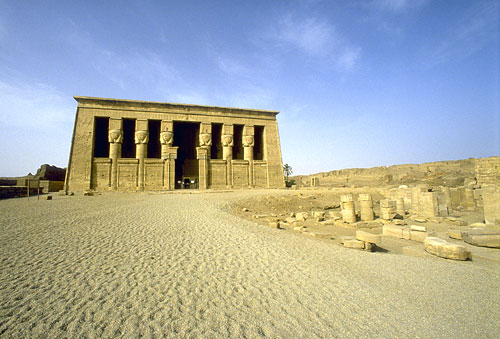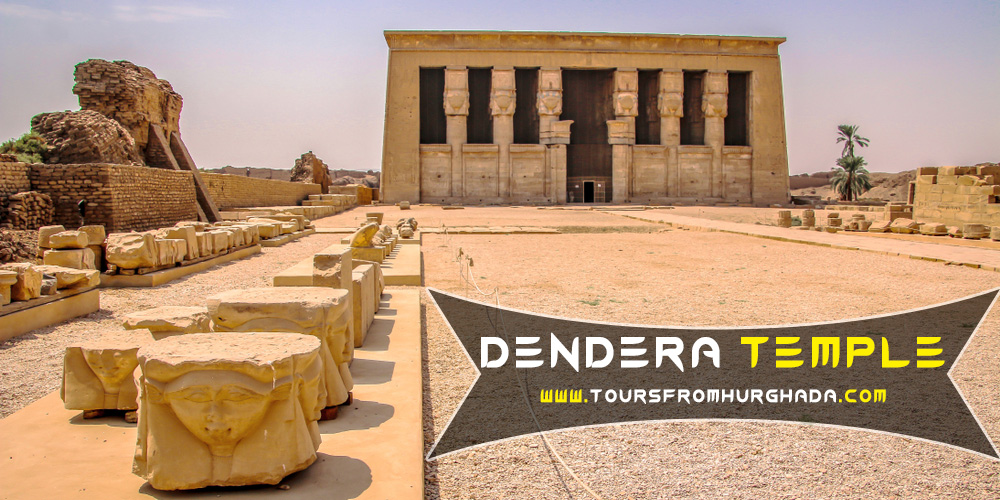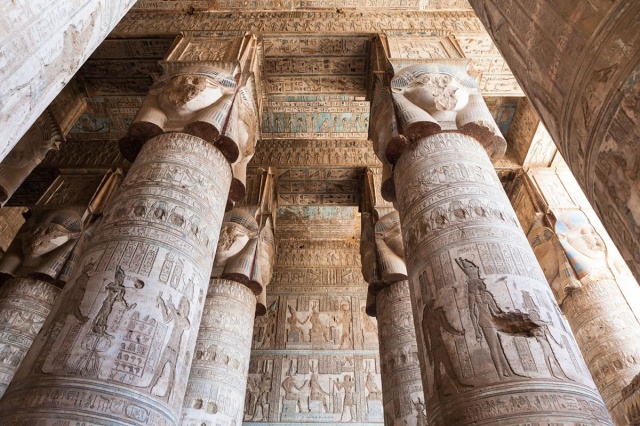The Dendera Temple: A Guide to This Fascinating Egyptian Monument
Travel back in time to ancient Egypt and step into the magnificent Dendera Temple, one of that era's most important religious centres. Located in the south of Qena in Egypt, the Temple of Hathor at Dendera is a complex with several sanctuaries and buildings attributed to different pharaohs and rulers. Despite being over 2000 years old, this temple still stands tall with its massive pillars, intricate hieroglyphics, and stunning artwork. Join us in this guide as we explore the history, significance, and fascinating features of the Dendera Temple.

Overview of Dendera Temple
The Dendera Temple, located in Egypt, is a magnificent and awe-inspiring ancient monument that dates back to the late Ptolemaic and Roman periods. Originally known as Tentyris, the temple complex boasts three sanctuaries, each dedicated to the gods Horus, Ihy, and Hathor. Of the three, only the Sanctuary of Hathor remains practically intact.
The temple's architecture and design deviate from the classic Egyptian style, as it does not feature the typical pylon in sacred Egyptian architecture. Instead, the front of the building is formed by a massive structure with six columns, on which an impressive cornice rests.
Visitors will walk inside the temple to marvel at the Great Sanctuary, the Birth House of Isis, the Sacred Lake and Sanatorium, and the Mammisi temples. The highlight of the Dendera Temple is the Dendera Zodiac, which visitors should not miss.
With its rich history and unique architectural design, the Dendera Temple is a must-visit destination that provides a glimpse into the life and culture of ancient Egypt. [1][2]

Importance of Dendera Temple in Ancient Egypt
As one of the most well-preserved ancient Egyptian temples, the Dendera Temple holds a significant place in the history and culture of Egypt. Dedicated to the goddess Hathor, the temple complex was considered a place of great importance for the cult of Hathor. It served as a centre for religious and astronomical study, with its most famous feature being the Dendera Zodiac - the oldest preserved depiction of the zodiac in history.
The temple complex also includes several other temples, sanctuaries, and shrines built during ancient Egypt, including the Middle Kingdom, the Ptolemaic era, and the Roman provincial rule. The site was believed to be a place where Hathor would journey to her husband Horus' temple in Edfu during a yearly celebration, marking the start of the flood season of the Nile.
Its architecture, rich decoration, and intricate carvings provide insight into ancient Egyptian beliefs, practices, and artistic expressions. As such, the Dendera Temple has played a crucial role in our understanding of ancient Egyptian history and culture, making it a must-visit destination for anyone interested in the fascinating world of ancient Egypt. [3][4]

Three sanctuaries of Dendera Temple
The Dendera Temple in Egypt is a magnificent complex that served as a vital religious centre for ancient Egyptians. The temple is particularly significant because of the three sanctuaries it was home to.
The first was the Sanctuary of Horus, the god of the sky, who protected the pharaohs. The second was the Sanctuary of Ihy, which was dedicated to the young sistrum-playing son of Horus. However, it is the third sanctuary, the Sanctuary of Hathor, that has survived mostly intact.
It is believed that Dendera had a sanctuary from ancient times, which was destroyed and rebuilt multiple times. The current complex dates back to the Ptolemaic and Roman periods, and the style of the temple is less rigid than that of older Egyptian temples. The temple of Dendera does not feature the typical pylon found in most Egyptian temples.
The front of the building is formed by a massive structure measuring 139 feet wide by 60 feet high with six columns on the façade on which an impressive cornice rests.
The sanctuaries of the Dendera Temple are well worth a visit for anyone interested in ancient religious history and architecture. [5][6]

Dates and periods of construction
The construction of the Dendera Temple can be traced back to as early as 2250 BCE, but the standing structures we see today mostly date from the Ptolemaic era forward. The oldest existing structure is from Nectanebo II, built around 345 BCE.
However, it may be more accurate to say the structure as we know it began in 54 BCE when construction on the Temple of Hathor began, the most prominent structure at the Dendera complex. The Temple of Hathor was primarily built during the Ptolemaic Dynasty, a period of Greek rule in Egypt and was completed under the Roman emperor Trajan.
This is why we can see Trajan and other Roman emperors depicted on the walls of the complex making offerings to Hathor. The complex also houses a monumental gateway constructed by Trajan and Domitian.
The Dendera Temple complex is a testament to the many different eras of Egyptian history and the cultural and architectural influences that shaped it over centuries. [7][8]

Architecture and Design of Dendera Temple
The architecture and design of the Dendera Temple are truly remarkable and a must-see for anyone interested in ancient Egyptian history. The absence of a traditional pylon at the front of the building is immediately noticeable, and in its place stands a massive structure supporting an impressive cornice.
The first hypostyle room is a magnificent chamber featuring 18 huge columns covered in intricate bas-reliefs dating back to the Late Ptolemaic and Roman periods. Panels of hieroglyphic texts and bas-reliefs occupy the intercolumniations, and the entrance opens up to form a high space wider than the adjacent ones.
The most interesting remains in the sacred enclosure include a Coptic church and two mammisi temples, one Ptolemaic and the other Roman, built to honour the pharaohs' children on the pretext of worshipping the birth of gods. The Dendera Zodiac, a bas-relief that has caused much intrigue and debate amongst Egyptologists, was once housed in the Temple of Hathor but is now on display at the Louvre in Paris.
Overall, the Dendera Temple's unique and intricate architecture and design are a testament to the skill and craftsmanship of the ancient Egyptians and should not be missed by any history enthusiast. [9][10]

The Great Sanctuary
The Sanctuary is a remarkable feature of the Dendera Temple. It stands out as the temple's main attraction, boasting 18 huge columns covered in bas-reliefs inside a magnificent chamber over 80 feet deep. The chambers were designed in the magnificently scenic style—a less severe style than that of the oldest Egyptian temples.
The temple of Dendera does not feature the usual pylon in sacred Egyptian architecture. Instead, the front of the building is formed by a massive structure measuring 139 feet in width and 60 feet in height, with six columns on the façade. The intercolumniations are occupied up to halfway by panels covered with hieroglyphic texts and bas-reliefs. At the same time, the entrance opens in the centre, forming a high space wider than the adjacent ones.
All the columns inside stand in three rows, and the capitals reproduce the features of the patron goddess of the place. As it is higher than the rest of the temple, this hypostyle room—added under Tiberius—acts somewhat as the missing pylon. The Great Sanctuary is an impressive architectural feat that will leave you in awe and is a must-see when you visit the Dendera Temple. [11][12]

The Birth House of Isis
The Birth House of Isis is a fascinating structure within the Dendera Temple complex, dedicated to the goddess Isis - the mother of the pharaohs. This small temple is situated on the eastern side of Hathor's Temple and is believed to have been used for celebrating the divine birth of Horus, Isis' son.
Exquisitely decorated with beautiful reliefs, the Birth House of Isis showcases the goddess and her divine son in various stages of their lives, depicting different legends about them, including their battles against evil and their role in the regeneration of the pharaohs.
In addition to its stunning reliefs, the temple has several significant features, such as a sacred pool, a room for offerings, and several small chambers that may have been used for ritual purposes. This temple is a significant example of the religious beliefs held in ancient Egypt and a testament to the ingenuity and creativity of the ancient Egyptian builders and artists responsible for constructing such magnificent monuments.
Visiting the Birth House of Isis is a must for anyone interested in ancient Egyptian history and culture. [13][14]

The Sacred Lake and Sanatorium
Within the walls of the Dendera Temple complex lies the Sacred Lake, a deep rectangular hollow enclosed by a boundary wall. This lake is typical of all Egyptian temples, where the priests had to perform their ritual ablutions several times a day. It is fascinating to imagine the priests carrying out their daily tasks, preparing themselves for worship in the temple.
Additionally, the complex features a Roman-period sanatorium, a place of healing where people sought to cure their ails through different methods, including thermal waters. The sanatorium is unique, as it features a mosaic that depicts the geometries of the human body, which is quite intriguing. It is amazing how advanced ancient Egyptian culture was regarding medicine and human anatomy.
The presence of the Sacred Lake and the Sanatorium further emphasizes the significance of the Dendera Temple in the lives of ancient Egyptians. Visiting the temple could provide a great learning experience and a chance to immerse oneself in such a vibrant past, something which cannot be found anywhere else in the world.
As with all ancient temples, the Dendera Temple is a testament to the progress and achievements of human civilization, a true marvel of the ancient world. [15][16]

Mammisi temples
The Dendera Temple complex is a remarkable feat of ancient Egyptian architecture and one of the most well-preserved in all of Egypt. One of the many fascinating elements of the complex is the Mammisi temples, which were built by the last native pharaoh, Nectanebo II, in 360-343 BC. These temples served as birthing houses for the goddess Hathor and were believed to be where Horus, Hathor's son, was born.
The Mammisi is characterized by its beautiful and intricate reliefs, depicting the gods' divine birth. The reliefs also include images of various gods and goddesses, including Hathor, Horus, and Ra.
Overall, the Mammisi temples are a testament to the incredible skill and creativity of the ancient Egyptians and an essential site for anyone interested in the country's rich cultural heritage. [17][18]

The Dendera Zodiac
The Dendera Zodiac is one of the most fascinating things in the Dendera Temple complex. It is a beautiful and intricate planisphere depicting the constellations in graphic form, and it is thought to be one of the best-preserved ancient depictions of the observable stars.
Although it contains many of the Zodiac symbols as they are known today, it is more accurately described as a star map than an astrological chart. The planet alignment shown on the Dendera Zodiac allows astrophysicists to date the sky depicted between June 15 and August 15, 50 BCE.
This unique depiction of celestial bodies is mysterious and very interesting. Historians suspect its creation and use may be linked to the death of Ptolemy Auletes in 51 BCE and the subsequent rise to power of his daughter Cleopatra VII, the last pharaoh of Egypt.
Seeing the Dendera Zodiac up close is an awe-inspiring experience you won't want to miss when visiting the temple. Make sure you take the time to appreciate the intricate details and the rich history behind this fascinating artefact. [19][20]

Encouragement to visit and experience for oneself.
Visiting the Dendera Temple should be at the top of any explorer's list as it is one of the most significant and well-preserved ancient Egyptian temples. One cannot help but awe its grandeur and architectural marvels. This temple is unique as it hosts not only one but three sanctuaries, with the Great Sanctuary being the most prominent among the three.
The temple also houses the Chapel of the Birth Home, famous for its paintings depicting significant events in Egyptian mythology. Moreover, the Sacred Lake and Sanatorium, along with the Mammisi temples, are some of the other remarkable features that make the Dendera Temple a must-visit place for enthusiasts of ancient Egyptian culture. Make sure to visit the Dendera Zodiac, an iconic structure that represents the astrological beliefs of the ancients.
This temple's beauty, rich history, and culture cannot be fully described in words, and the only way to fully appreciate its wonders is to experience it for yourself. It is a perfect place for those who love to explore and learn about new cultures and traditions. If you plan a trip to Egypt, add visiting the Dendera Temple to your itinerary, and you will not regret it. [21][22]
